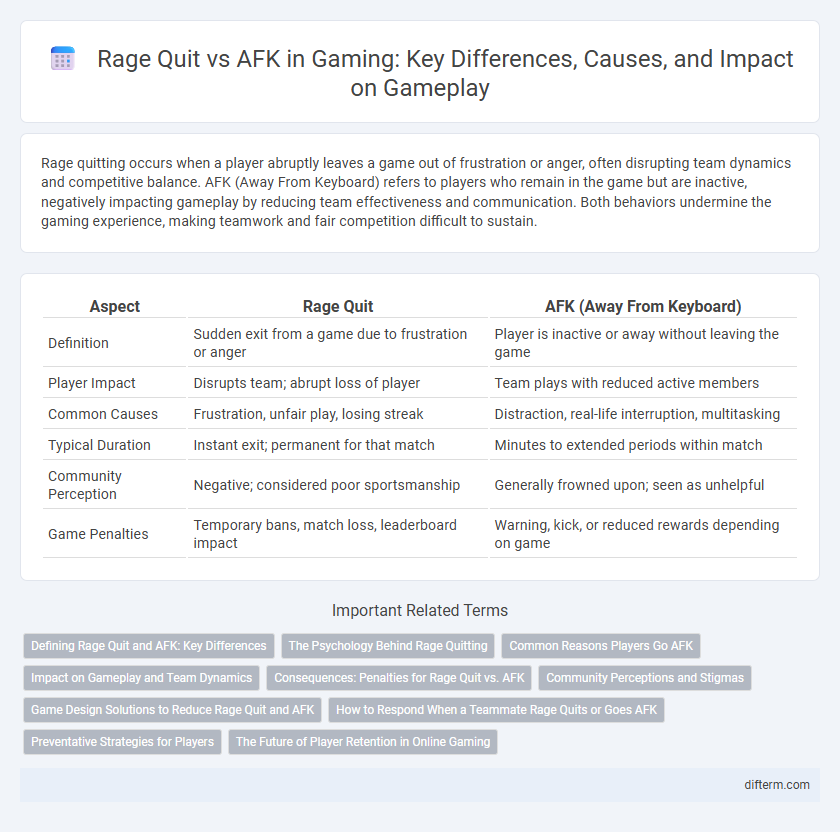Rage quitting occurs when a player abruptly leaves a game out of frustration or anger, often disrupting team dynamics and competitive balance. AFK (Away From Keyboard) refers to players who remain in the game but are inactive, negatively impacting gameplay by reducing team effectiveness and communication. Both behaviors undermine the gaming experience, making teamwork and fair competition difficult to sustain.
Table of Comparison
| Aspect | Rage Quit | AFK (Away From Keyboard) |
|---|---|---|
| Definition | Sudden exit from a game due to frustration or anger | Player is inactive or away without leaving the game |
| Player Impact | Disrupts team; abrupt loss of player | Team plays with reduced active members |
| Common Causes | Frustration, unfair play, losing streak | Distraction, real-life interruption, multitasking |
| Typical Duration | Instant exit; permanent for that match | Minutes to extended periods within match |
| Community Perception | Negative; considered poor sportsmanship | Generally frowned upon; seen as unhelpful |
| Game Penalties | Temporary bans, match loss, leaderboard impact | Warning, kick, or reduced rewards depending on game |
Defining Rage Quit and AFK: Key Differences
Rage quit refers to a player abruptly leaving a game due to frustration or anger, often disrupting the gameplay for others, while AFK (Away From Keyboard) indicates a player is temporarily inactive but still connected to the game. Rage quitting is an emotional response causing immediate exit, whereas AFK status might result from multitasking or short breaks without intent to abandon the match. Understanding these behaviors is crucial for developers to implement features that mitigate negative impacts on multiplayer gaming experiences.
The Psychology Behind Rage Quitting
Rage quitting stems from heightened emotional responses triggered by frustration and perceived unfairness in gaming, often linked to the brain's fight-or-flight mechanism activating under stress. Players experiencing rage quitting typically lack emotional regulation, leading to abrupt game exits to avoid negative feelings such as anger and humiliation. Unlike AFK (away from keyboard) behavior, rage quitting is an impulsive act driven by psychological stress rather than intentional disengagement or multitasking.
Common Reasons Players Go AFK
Players commonly go AFK (Away From Keyboard) due to technical issues such as hardware malfunctions or connectivity problems, which disrupt gameplay and force temporary absences. Frustration stemming from team conflicts, negative in-game experiences, or perceived unfairness often leads to players disengaging without leaving the match, contrasting with the immediate exit of rage quitting. Understanding these factors highlights the importance of improved network stability and positive community management to reduce AFK incidents in multiplayer gaming.
Impact on Gameplay and Team Dynamics
Rage quitting disrupts gameplay by abruptly removing a player, causing team imbalance and often leading to immediate loss conditions or reduced chances of winning. AFK (away from keyboard) behavior similarly hampers team dynamics by creating resource and objective deficits, but it may allow for limited in-game participation, unlike rage quitting's total disengagement. Both behaviors decrease overall team coordination and morale, negatively impacting competitive match outcomes and player retention rates.
Consequences: Penalties for Rage Quit vs. AFK
Rage quitting in gaming often results in harsher penalties such as temporary bans, loss of ranking points, and restricted matchmaking access due to its disruptive impact on team dynamics. AFK (Away From Keyboard) behavior typically incurs milder consequences like reduced experience gains, minor point deductions, or temporary matchmaking delays aimed at discouraging inactivity. Both actions negatively affect player reputation and game fairness, but rage quitting carries a higher penalty severity because it reflects intentional abandonment.
Community Perceptions and Stigmas
Rage quitting in gaming often attracts negative stigma for displaying poor sportsmanship and emotional instability, while AFK (Away From Keyboard) behavior is perceived as irresponsible and disruptive to team dynamics. Community perceptions generally label rage quitters as toxic players who undermine the competitive integrity, whereas AFK participants are seen as neglecting their obligations, frustrating teammates and harming cooperative gameplay. Both behaviors harm the gaming experience, but rage quitting is typically viewed as more aggressive, whereas AFK can be interpreted as passive abandonment.
Game Design Solutions to Reduce Rage Quit and AFK
Implementing real-time adaptive matchmaking and reward systems significantly reduces rage quit and AFK behaviors by maintaining player engagement and balancing skill levels. Game design solutions such as providing clear feedback, gradual difficulty curves, and implementing soft penalties for prolonged inactivity effectively discourage AFK actions. Incorporating social features and fostering positive community interactions further minimizes frustration-driven rage quits and enhances player retention.
How to Respond When a Teammate Rage Quits or Goes AFK
When a teammate rage quits or goes AFK during a gaming session, maintaining composure and adjusting your strategy can minimize the impact on the team's performance. Communicate clearly with remaining players to reorganize roles and focus on objectives, leveraging teamwork to compensate for the missing player. Utilizing in-game tools like muting disruptive teammates and reporting persistent offenders helps preserve a positive gaming environment and can prevent future rage quits or AFK incidents.
Preventative Strategies for Players
To reduce rage quitting and AFK behavior, players should manage in-game frustration by taking scheduled breaks and setting realistic performance goals. Communication tools like team chats and positive reinforcement systems encourage cooperative gameplay and minimize feelings of isolation. Implementing time management techniques and practicing emotional control can significantly improve overall gaming experiences and player retention.
The Future of Player Retention in Online Gaming
Rage quitting and going AFK present distinct challenges for player retention, with rage quitting often signaling frustration and AFK behavior indicating disengagement. Future player retention strategies will rely heavily on adaptive AI to detect and respond to these behaviors in real-time, fostering more personalized, supportive gaming environments. Enhanced telemetry and player feedback loops will allow developers to implement dynamic difficulty adjustments and community-building features that reduce frustration and promote sustained engagement.
rage quit vs AFK Infographic

 difterm.com
difterm.com